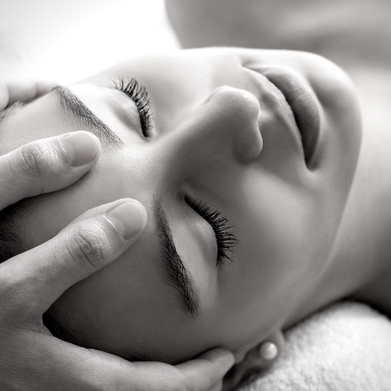|
JOIN OUR
MAILING LIST
|
|
The title almost sounds like the start of a joke, right? Four people enter a pub – depression, anxiety, the Vagus nerve and craniosacral therapy. During my Craniosacral education we studied the Vagus Nerve, learning the theory and practicing the different vagal tones by doing hands on work, feeling for the dorsal and ventral branch of the Vagus Nerve. At the time for me, the theory was mostly words on paper about Stephen Porges Polyvagal theory. This is not a light subject matter to begin with and as my course and study materials were conducted in German (not my first language)...…well let’s just say Stephen Porges “Die Polyvagal theorie: die phylogenetische entwicklung des Nervensystems” got filed away in the “one day – too hard” basket of my brain.
Many years later and firmly established in my own clinic, that one day came, when a Psychiatrist started to refer some of his clients with various diagnoses like: Insomnia, Anxiety, Depression and Fibromyalgia to me. This psychiatrist advocates non-medicinal treatment in finding alternative ways to help his clients through TMS, neurofeedback and stimulating the Vagus Nerve, in my case, through Craniosacral Therapy. As I treated his clients, I started to notice various similarities. All had an under-activated dorsal branch of the Vagus nerve, a compression at the Cranial base and different parts of the brains that would be overactive, i.e. over fire on a neural level. I knew I had to revisit Stephen Porges Polyvagal theory and as it turned out, it also confirmed a piece in my own personal journey. The Vagus Nerve and the differences between the functions of the ventral and dorsal branch of the Vagus Nerve have great implications in the healing of our physical, mental and emotional health. In this blog I will mainly focus on the Dorsal Vagal Nerve, as a chronic activation of dorsal vagus circuit is accompanied by depressive feelings as in loss of interest in activities and surroundings, digestive problems, reduced energy, not being active, sad and/or being anxious. Working with the Dorsal Vagus Nerve through CST, has a great potential for treating people with Depression, Anxiety and Insomnia. Vagus Nerve In previous blogs I have written about the Autonomic Nervous System (ANS) and its 2 key branches the Parasympathetic nervous system (PNS - rest and digest) and Sympathetic nervous system (SNS - fight and flight). They should ideally go up and down during the day in a balanced rhythmic way. The Vagus Nerve is part of our PNS and is one of the 12 Cranial Nerves (Cranial Nerve X) that regulates most of our bodily functions for our health, relaxation and emotional well-being (75%), i.e. stabilising our heart rate, breathing & digestion. The Vagus is the largest ANS nerve, starting in the brainstem at the base of the skull and going through the neck into the chest and abdomen regulating many of our organs, from the heart, to the lungs, to the gut. In below picture you can see its pathway into our organs, where the fibers of the Vagus Nerve act as a surveillance team of our internal organs sending the information up to our brainstem for processing and actioning. New Model - Polyvagal Polyvagal as a relative new model (1994) states we have the SNS – fight and flight but that the relax and digest Vagus Nerve has 2 branches (in the classic ANS model the assumption is one vagus nerve). Polyvagal states that there are 2 separate distinct vagal nerves that originate in 2 different locations and have 2 different neural pathways. They are:
Ventral Vagus Nerve When there is a threat or stress in our environment, we rely on our VVN to establish a sense of safety and connection, this can be through conversation, a call for help, making eye contact, a calming voice etc. This will send signals down to our heart and lungs, slowing down our heart rate and deepening our breathing. It is also referred to as the Social Nervous System and in essence functions as brake – Vagal Brake – having a calming and soothing effect on our nervous system. If the social nervous system fails to resolve the stress and it remains active in our body, then we will automatically resort to the older biological response of fight/flight. Dorsal Vagus Nerve When the fight/flight mode fails to resolve the stressor, we then subsequently resort to our oldest biological primitive ultimate emergency response through the Dorsal Vagus Nerve. A sudden extreme surge in dorsal vagal activity can for instance happen when we are faced with great danger. It is a defensive strategy that helps us cope in a traumatic event, or with prolonged extreme stress or danger, real or imagined and can bring our body in a state of “immobilisation with fear”. Much like a cockroach playing dead when he knows his time is up and senses a human being with a spray in their hand (Very much a Sydney thing:). “A chronic activation of dorsal vagus circuit and its physiology is characterised by depressive feelings. For example, loss of interest in activities that were once pleasurable, loss of appetite, overeating, digestive problems, reduced energy, sad, anxious, problems remembering, making decision and also fibromyalgia. Diagnosis of depression are usually accompanied by a state of activation of the dorsal branch of the Vagus nerve. If the transition into a dorsal state has involved a sudden surge in dorsal branch activation, via a shock, a shutdown results. In a dangerous situation, it is a natural reaction to dissociate from one’s own body from the here and now, and to shut down physically, emotionally and mentally”. (Stephan Rosenberg, 2017). It is exactly in these words that I found the missing piece of my own personal puzzle. In a previous blog I have written about my own physical and emotional trauma. I was certainly displaying symptoms of depression after the trauma and had many other symptoms including insomnia, anxiety and digestive problems. I was given the label of Depression and heaps of chemical pills. I felt I was not depressed in the classic sense of Serotonin deficiency and I did not want a different pill for every one of my symptoms. I intuitively knew but did not have the knowledge at the time that my answers did not lie in the medical chemical world. It seemed like a valued but incomplete model, as the primary innate biological forces that controlled all of my symptoms seemed to be overlooked, disregarded and not worked with. I now understand that there was a huge activation of my Dorsal Vagus Nerve – partly due to the physical violent head trauma and partly due to the shock and trauma that accompanied it and therefore pills and classic talk therapy did not work for me, as it did not address nor rebalance my Vagus Nerve, its pathway into my organs and digestive system or my Trauma. Symptoms of Dorsal Vagal State – Shock/ shutdown The body is truly amazing and in my humble opinion quite undervalued in the western medical conditioned ‘machine-like’ approach. We don’t always have to take out parts, replace parts or fill it up with chemicals to suppress symptoms. We can work with the body, feel the body, regulate the body, regulate the nervous system, reset its physiology, get nerves to fire under their threshold in many ways, and here through the Vagus Nerve. I witness this every day in my practice and am always humbled by the body’s innate power, it’s infinite wisdom and the body's capacity to heal. The below symptoms are designed to keep the basic functions going as it can override less important functions in the body, in times of stress or emergency. The problem lies, when we stay in that very state that was initially only designed to save us and when chronic, will turn against us. Physical and emotional symptoms of Dorsal Vagal activation:
Craniosacral Treatment for Chronic Dorsal Vagal Activation The basic goal of CST treatment is to lift the client from a chronic Dorsal Vagal state into activation of Ventral Vagus Nerve. During a CST treatment and with our subtle movements and it’s subtle as we listen, feel, touch and work with the most delicate structures of the body, we aim to: 1. Balance the Ventral and Dorsal Branches of the Vagus Nerve. This can be done by mobilising the cranial bones to reduce any pressure on the cranial nerves as they come through various openings into the skull and/or bringing both branches back into balance. 2. Restoring, calming and strengthening the Nervous System, resetting its physiology so it can start to self-regulate. 3. Bringing the nerves back under their firing threshold 4. Releasing any compression/jamming at the base of the Skull to increase blood flow and oxygen back into our brain. 5. Letting the body come back into balance so that any symptoms of depressive behaviour and shutdown can be reversed, regulating breathing & digestion. 6. Maximise the movement of CSF (clear liquid that circulates around our brain and spinal cord and carries a lot of nutrients and carries away waste product) so metabolic waste products can be better eliminated and tissues nourished. 7. Freeing the connective tissues and its structures in the skull (Dural membranes) and around the cervical neck vertebrae’s. Conclusion The positive effects of craniosacral therapy are cumulative. Over time our ANS becomes more resilient each time we can restore a state of our social nervous system following activation of the dorsal vagus branch. The long-term goal is to encourage the ANS to return naturally, on its own from a state of dorsal stress to a state of social engagement, were we feel physically and emotionally safe. Healing the Nervous system does take time, but with time and for me personally with skilled hands-on craniosacral work for all my physical and emotional symptoms, I was able to shift back into the Ventral Vagal state, into a state of social engagement - my Social Nervous System where I was able to reconnect, relax and feel immense joy and happiness again. As Stephen Rosenberg writes in his book – Accessing the Healing Power of the Vagus Nerve: “prior to Polyvagal, depression and depressive behaviours issues lacked a physiological model in terms of the nervous system. Perhaps why it is difficult to find effective treatments for conditions like depression. With Stephen Porges Polyvagal theory we have a clear focus on relationships of the ANS, the emotions and the behaviours”. The Vagus Nerve is responsible for our health and essentially controls our entire rest and digest and all the associated organs. So, depression, anxiety, the Vagus nerve and insomnia walk into a bar, ordering craniosacral. All having a healthy drink together around a communal table, working together in harmony, in a balanced rhythmic way, with no side effects or hangover. What are you ordering? ___________________________ My next blog will focus on the VVN – Social Nervous System and the implications for our physical, mental and emotional health through Craniosacral Therapy. References:
0 Comments
Leave a Reply. |
AuthorDorine Siccama.com Archives
August 2023
Categories |


 RSS Feed
RSS Feed